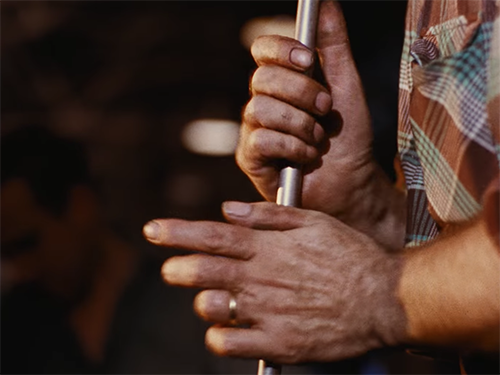
“In 1957 kreeg Bert Haanstra de opdracht van de Verenigde Glasfabrieken Leerdam om een bedrijfsfilm te maken waarin het productieproces werd getoond. Met de film wilde het bedrijf haar reputatie van vakmanschap en innovatief design (onder leiding van Andreas Copier) hooghouden. Terwijl hij opnamen in de fabriek maakte, kwam Haanstra tot de ontdekking dat het onderwerp stof voor meer dan één film bood. Hij kreeg van de opdrachtgever toestemming om naast de bedrijfsfilm in zwart-wit - die de titel Over glas gesproken kreeg - een ‘vrije film’ in kleur te maken, waarin hij zijn fantasie de loop kon laten. De productiekosten van die film, Glas, nam het Ministerie van Onderwijs, Kunsten en Wetenschappen voor haar rekening. Voor Glas monteerde Haanstra beelden van de verschillende facetten van glasfabricage, die met aandacht voor details ritmisch op muziek werden gezet door Pim Jacobs. De film was direct een groot succes: bij de pers, op internationale filmfestivals en bij het grote publiek. In 1960 mocht Haanstra zelfs een Oscar voor de beste korte documentaire in ontvangst nemen. Korte tijd later kwam de duizendste kopie van Glas in omloop. De film is jarenlang als materiaal gebruikt in lessen filmmontage op filmscholen over de hele wereld.”
Eye Korte Film Poule1
“Viscosity of hot and glowing semi fluid glass being moulded into magnificent glass articles by the sheer skill of human body – a hand rolling pipes, mouths puffing to calibrate the girth and thickness of glass, contours forming under the gentle touch of hands, delicate curves emerging around a finger – shot in tight and sensuous close-ups affirm the beauty and the awe of human creation. To take something elemental – a stone, a chemical, a word – and transform it into a thing of beauty – by sculpting, by intervening, adding, negating, composing, by infusing in it a character unforeseen yet imagined – in one word art – which manifests often in crafts as well – is celebrated with a romantic fervour in these images. The question arises – such a transformation happens in a factory as well; then what differentiates the value of the products created by human endeavour and those created by machines en-mass. It is perhaps, as the film suggests – a flaw. This artistic flaw is the beauty of human creation – the impossibility of cloning as each man/creator infuses a unique character, a personality, a tone – however little or negligible- into the object he is making with his own hands and lungs and eyes- is removed from the impersonal perfection of mass production. He is at once at Eliot would say working in a tradition but with individual talent. We never see two or more completely identical objects being churned out by different workers in the workhouse – unlike the perfect copies that the bottles produced on the assembly line are. This perfection of industrial production is also questioned in a sequence reminiscent of Chaplin’s Modern Times (1936), where just one little fault of a bottle on the assembly line breaks the normalized chain and the bottles start collapsing one after the other. The robotic hands of a machine unlike a man’s cannot act with thought and imagination to intervene and mould the situation – it keeps looping futilely in its instructed drone. Unlike the workers who are involved in the entire process of the creation comprising of several operations performed on a single object, in an assembly line each worker gets to be part of a single fragmented operation on several clone like objects. This degrades, severely the affection, reverence and intimacy felt by the worker towards the product. As in one of the telling sequences, where a worker in a Fordsian factory carefully and skilfully rolls a joint, much like the workers creating glassware from scratch in the workhouse, but he very casually lights that joint with a hot piece of glass picked out of the assembly line with absolute irreverence.”
Prashant Parvatneni2
- 1“Glas,” Eye Korte Film Poule.
- 2Prashant Parvatneni, “Bert Haanstra's Glas (1958). Style of Substance,” The Essential Mystery, blog, 30 November 2014.

